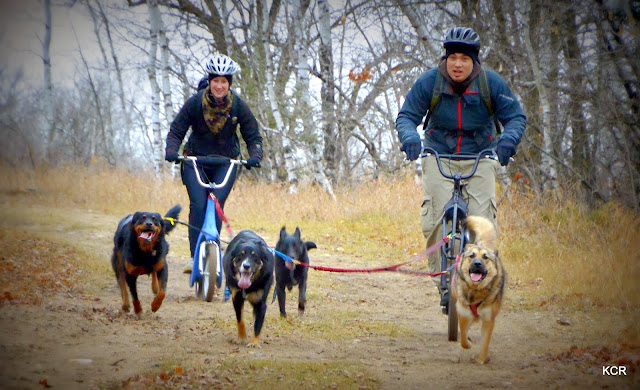Meet Carol. Carol lives in Fairbanks, Alaska, with her husband and two retired sled dogs. She is coauthor of "Skijor With Your Dog." She has been running dogs in one form or another for about 35 years.
What dog powered sports have you been involved with?
Skijoring, dog mushing, kicksledding, canicross, dog carting, and one session on inline skates behind a smooth-trottng malamute. (We don't generally recommend it, but I have to admit it sure was fun.)How did you first get started in the sport?
When I first came up to Alaska in 1977, I learned to cross country ski. I skijored once behind a friend's dog and thought it was amazing. When I got my own dog, Willow, a few years later, she and I went skijoring at every opportunity and we both fell in love with the sport. Willow and I went on to meet Mari Hoe-Raitto, and the rest, as they say, is history.When did you know you were hooked on the sport?
I had only one dog for several years, and though I was totally hooked on skijoring, I wouldn't say it had become a lifestyle yet. That started to develop when I acquired a couple more sled dogs around 1986. It was subtle at first, but I think I knew by 1988 that I was seriously addicted.
What is mushing like in your neck of the woods?
Fairbanks is dog-mushing heaven in a lot of ways. You can meet dog mushers and skijorers pretty much everywhere you go. We have miles and miles of trails and a long mushing season, although it does get a little cold on occasion.Our sprint-racing club is going through some troubles right now, but our local skijoring club is going strong and holds lots of fun races and beginner clinics. The Yukon Quest starts in Fairbanks every other year. So there's lots of ways to get involved with dogs and dog-driving.
What is your favourite activity to do with your dogs?
It's a toss-up between dog mushing and skijoring. I love them both.
Tell us about your relationship with dogs.
My folks got an English setter when I was two years old, so Loki and I were puppies together. Dogs were always a part of my life, strictly as pets. When I first started skijoring, I was struck by the difference in my relationship with Willow. We communicated so much better when we started working together. I felt as if we became a team. It's been that way with every dog since—when we work together, it deepens and enriches our relationship.
What have dogs taught you?
One thing I've learned from working with dogs is how subtle they can be. An ear flick, a tilt of the head, a tail held just a tiny bit higher or lower than normal, a softening of the eyes, all are signs that may be hard to read, but can mean a lot.
Describe a perfect run with your dogs.
Sometimes the dogs and I just fall into sync. There's no other way to describe it. They know where I want to go, the conditions are right, I feel as if I'm an extension of the sled or of my skis, and I can tell the dogs are particularly delighted to be running. Everyone comes home happy from a run like that.
What is the best advice you have ever been given for mushing?
I guess I'd say three pieces of advice compete with each other for "best I've ever been given." (1) Never stop learning. (2) Always look where you want your dogs to go, and always expect the dogs to take the right turn (even while you're ready for anything). (3) Believe the best of your dogs and they'll live up to your expectations.
What resources (websites, books, people, etc) have you used to further your training?
When Mari and I began working on the second edition of "Skijor With Your Dog," I picked up several books on dog behaviour and training that have proved enlightening and really invaluable in becoming a better dog trainer. My favorites were "Dog Sense," by John Bradshaw, "Bones Would Rain from the Sky," by Suzanne Clothier, and "The Other End of the Leash" and "For the Love of a Dog" by Patricia McConnell. One of the best books on dog mushing I've read is "Dog Driver: A Guide for the Serious Musher" by Miki and Julie Collins.
 |
| Check out "Skijor With Your Dog" on Facebook! |
What was your "take away" from The Colins book "Dog Driver"? How has that book inspired you? For me, I really loved their sens of adventure, and to never stop learning.
I like how comprehensive "Dog Driver" is, and of course I love the stories, but what sticks with me the most is the material on reading your dog. To quote from the book, "If you take anything away from this book, it is that you must understand dog behavior in general and your dogs' behaviors in particular" (27).
Why do you run your dogs?
Besides the fact that I love being around dogs? I've been a scrawny little thing all my life, and I was never athletic. I was always the last one picked for team sports. It's impossible to describe what it means to take someone like me, a physically nondescript, noncompetitive woman, and stick her on a dogsled behind a bunch of fast dogs. It's exhilarating.
I like what running dogs does to my mood, too. I can be grumpy and tired from work or just a bad morning, but when I go out with the dogs, everything changes. It's one of the best attitude adjustments I know.
These photos may not be used without permission of Dave Partee, Sled Dog Studio.






.JPG)











